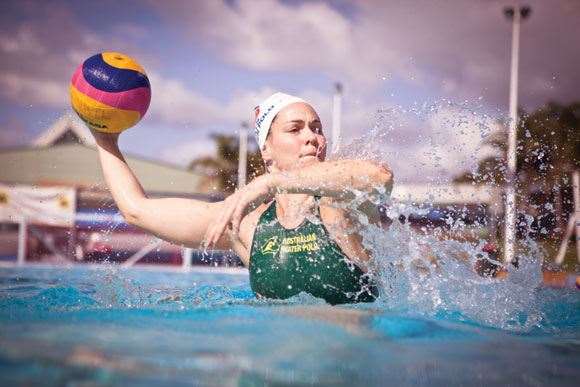Water polo is a sport made to measure for the Australian psyche: it’s rough, it’s tumble, and it’s played in water.
 Photos By, Shelby Hayden Craig
Photos By, Shelby Hayden CraigWater polo is a sport made to measure for the Australian psyche: it’s rough, it’s tumble, and it’s played in water.
Water polo is a sport made to measure for the Australian psyche: it’s rough, it’s tumble, and it’s played in water. With its end-to-end speed, its intricate tactics and its one-on-one battles, it’s damn-near footy in the briny. And yet, oddly, this game remains a bit player on our sporting stage. Indeed, if there was ever a match to lift this game into our collective gaze, then it was the women’s gold medal match at the Sydney Olympics. The Australian and American girls fought out a brutal contest; the locals hitting the lead, the Yanks gobbling it up. When the Americans nailed a levelling goal with 12 seconds on the clock, the match seemed destined for extra-time. Enter Yvette Higgins. With 1.3 seconds remaining, she unloaded a long-range, left-handed shot that clipped the fingers of two defenders before filling the American net. That 4-3 victory should, by rights, have dragged water polo out of its corner and dumped it in the deep end of Australian sport. Instead, the game slipped beneath the surface once more ...
Twelve years on, the Stingers (yep, that’s their name) will have another shot at Olympic glory. They’ve already qualified for the London Games and will fancy their chances against the Americans, the Chinese and the Euros ‒ all of whom have proven eminently beatable over the past few years. And if the Stingers are to take the top step of the London dais, they’ll need plenty from 21-year-old Sydneysider Nicola Zagame. Described by those in the know as one of the purest athletes in the women’s game, Zagame is the central support of the team’s defensive structure. Strong, fast and armed with a lethal right-handed outside shot, she could well prove the Stingers’ trump card come August.
On the move
“Growing up, I was always a driver, an attack player. I loved scoring goals – still do. But when I got into the national team, after the Beijing Games, a lot of the centre backs had just retired. Because I’m not a little girl, and because I’m quite strong, our coach Greg McFadden decided to convert me into a defender, into a centre back. Basically, that position allowed me to defend and attack – keep a few tricks up my sleeve. Training-wise, this meant I had to start doing a lot more leg work in the gym and the pool, getting my kick nice and strong. As a centre back, I have to do a lot of wrestling with centre forwards, whereas drivers tend to work more on ball skill exercises.
“The centre back is the leader in defence. You’re the key communicator who tells the other girls what type of defence you want. So again, training-wise, that meant I had to start watching a lot of game footage, doing my research. For me, the hardest thing was making all those decisions in defence, because previously I’d been the one following. I was only 18, so I found that adjustment really difficult. It was nerve-wracking ‒ I didn’t exactly know what I wanted from the other girls in defence.”
Battle plan
“There are so many different types of defence a team can adopt. There’s the full-pool press, where it’s just one-on-one with your team-mates, everyone pushed up heavy. Then there’s the three-back, where three people up the pool drop back. Then there’s the wing drop, or the ladder, or the counter attack defence ... There are so many types. In the pool, I just call a name and everyone knows what their role is. Then, from there, if they feel that another defence is required, they can tell me or tell the team. It’s a communication web – I just make the first decision and the rest of the strategy develops from that.
“Water polo’s a very intricate game. The coach and the assistant coach spend an infinite amount of time studying video footage of other teams. You’ve got the top nine teams in the world at the moment – Australia, USA, Canada, Russia, the Netherlands, Greece, Italy, Hungary and China – who are all so close that any given team can win on any given day. So tactics are really important.”
Related Articles

Bronzed finish for Stingers at World Championships













